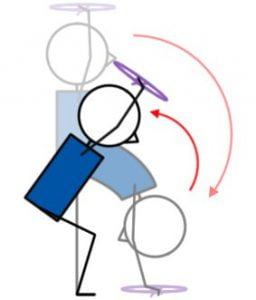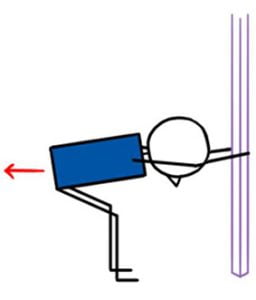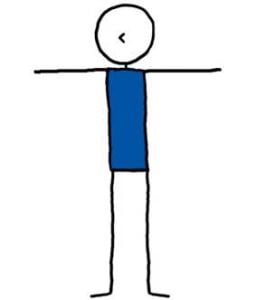
| Category: | Pilates Lesson Planner |
|---|---|
| Sub Category: | |
| Types: | Balance, Hip Opener, Standing, Strengthen, Stretch |
| Anatomy: | Arms & Shoulders, Core, Hamstrings, Hips, Knees, Psoas |
| Chakras: | Base, Heart Centre, Sacral Centre, Solar Plexus Centre |
| Therapy: | Back Pain, Poor Posture, Sciatica |
| Drishti: | Tip Of Nose |
| Dosha: | Kapha, Pitta |
| Meridian Lines: | Stomach |
Start in a standing forward fold. Widen the feet further than hip-width apart, feet facing forward. Slowly and mindfully drop the seat toward the ground, bending the knee and taking care to listen to the joint ability (avoid pushing the knees out of alignment). Notice which parts of you stop you from getting down to the full squat position with your feet flat on the floor. Instead of gripping at the top of the hips, see if you can release them there. If you can make it there, bring hands to prayer, and hold for 5 breaths before taking hands above your head, lifting the chest (avoiding rounding out the back).
Hip opener. Strengthens thighs, buttocks, and hamstrings. Improves posture.
A) Sit on the front edge of a chair. B) Bring arms to tops of legs. C) Sit your back against a wall like you are in a chair. D) Add a squat twist.
Knee injury.
Click here for lots of FREE downloadable Yoga lesson plans.
Click here for lots of FREE downloadable Pilates lesson plans.
- Ask Genie1
- small ball 1
- Mat Standing 2- Bow & Arrow
- Ask Genie2
- Ask Genie1
- 10 pamoka Mat Pilates
- Ask Genie3
- 15 intermediate matwork
- 16 Beginners Intermediate
- Lockhart ball 01
- School, Family class May 23
- 16 Beginners Intermediate
- Upper & Lower Body Mobiliser
- test 2
- Ask Genie 1
- Ask Genie 1
- Ask Genie 2
- Stick 1
- Ask Genie 1
- Stick 1
- Ask Genie 1
- Ask Genie 1
- Saturday morning cover - Full Body Strap Mixed Ability Lesson Plan
- Mat Exercises
- Mat Pilates
- Mat Exercises lesson plan to work on
- Ask Genie 2
- Ask Genie 2
- Ask Genie 5
- Debbie Pilates 4
- Ask Genie 1
- Miniball May
- Susan 26.04.25
- Leg & Booty Burner
- Ask Genie 2
- Ask Genie 2
- Ask Genie 1
- Leg & Booty Burner
- Ask Genie 6
- Ask Genie 7
Squat Mobility Test Pilates Exercise FAQs
What are the teaching directions for the Squat Mobility Test?
Start in a standing forward fold. Widen the feet further than hip-width apart, feet facing forward. Slowly and mindfully drop the seat toward the ground, bending the knee and taking care to listen to the joint ability (avoid pushing the knees out of alignment). Notice which parts of you stop you from getting down to the full squat position with your feet flat on the floor. Instead of gripping at the top of the hips, see if you can release them there. If you can make it there, bring hands to prayer, and hold for 5 breaths before taking hands above your head, lifting the chest (avoiding rounding out the back).
What are the benefits of the Squat Mobility Test?
Hip opener.
Strengthens thighs, buttocks, and hamstrings.
Improves posture.
What are some modifications to the Squat?
A) Sit on the front edge of a chair.
B) Folded blanket under heels.
C) Lift all ten toes up.
D) Bring arms to the tops of legs and reach outward.
E) Sit back against a wall like you are in a chair.
F) Add a twist.
G) Sit on a block.
H) Roll a blanket and place it in the crease of both knees.
What are other names for Squat?
- Deep squat pose
- Sitting down pose
What’s the most important thing to be aware of in a Squat?
Make sure that the knees are pointing in the same direction as your toes.
What should I be aware of when in a Squat?
Squat pose challenges will challenge your entire body because it requires mobility and stability in the ankles, knees, hips, pelvis, and spine.
When in the pose silently ask yourself these questions:
- How does it feel?
- Where do I feel it?
- Are my heels lifted (the goal is to have the heels down)?
- Are my ankles rolling in?
- Are my arches collapsed?
- Are my toes turning out excessively (or do they want to)?
- How do my knees look and feel?
- Are my knees collapsing in?
- Is one knee collapsing in more than the other?
- Is one hip closer to the ground?
- Am I leaning to one side?
- Is my spine straight, arched, or rounding forward?
- Is my tailbone tucking under excessively?
If my heels are lifted when in a Squat, what does that mean?
If your heels are lifted, it usually indicates a limitation in the Achilles tendon and calves. Allow your heels to lift and over time, with regular practice, the heels will lower down to the floor. It may also indicate hamstring tightness, piriformis tightness, or weakness in the gluteus medius. An easy way to make the pose more accessible is to place a rolled-up towel or blanket under the heels for support. If your heels are close to the ground, try widening your feet and turning the toes out.
How wide should my stance be in a Squat?
Have fun experimenting with a wide and narrow stance to find the ideal Squat pose width for you. There is no one-size-fits-all.
If my heels are knees collapsed when in a Squat, what does that mean?
If your knees are collapsed (hips are internally rotated), you may have weak gluteus muscles, tight adductors (inner thighs), or a tight iliotibial band (a band of fascia along the outside of the leg from the hip to the knee).
If my low back is arched excessively when in a Squat, what does that mean?
If your low back arches excessively, you may have tight hip flexors that are compensating for weak core muscles.
If my spine is rounded forward when in a Squat what does that mean?
If your spine is rounded forward, you may have weak erector spinae muscles (iliocostalis, longissimus, and spinalis), a tight thoracic (middle) spine, or tight hamstrings.
If I lean to one side when in a Squat, what does that mean?
Leaning to one side could mean that you have a stability problem or an asymmetry (two sides that are not the same) of the ankle, knee, or hip.
If one shoulder is higher than the other in a Squat, what does that mean?
It’s common for the shoulder of our dominant side to be tighter, and less mobile.




 Yoga Lesson Planner
Yoga Lesson Planner
 Pilates Lesson Planner
Pilates Lesson Planner


















